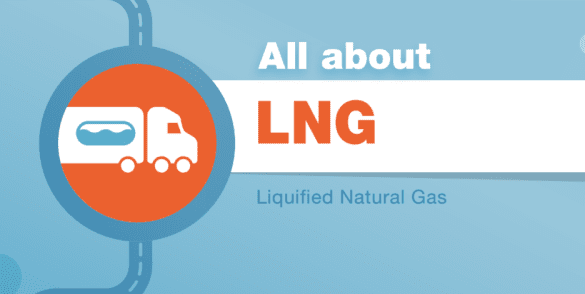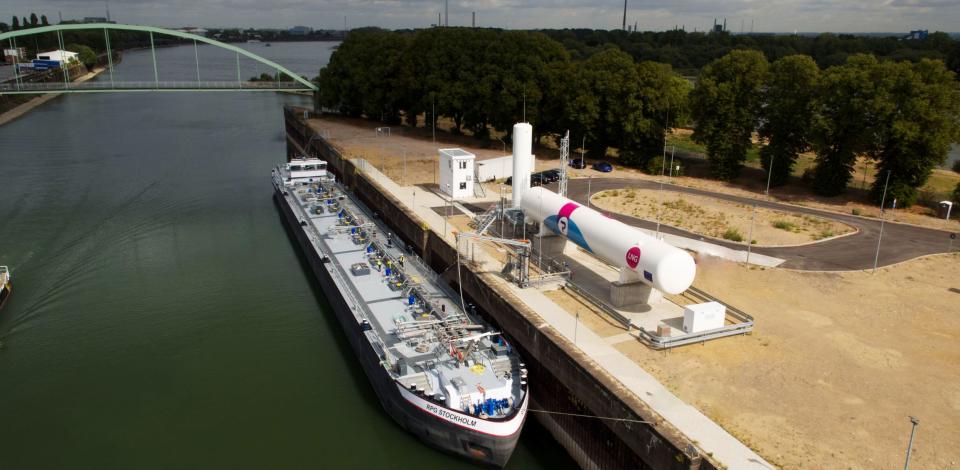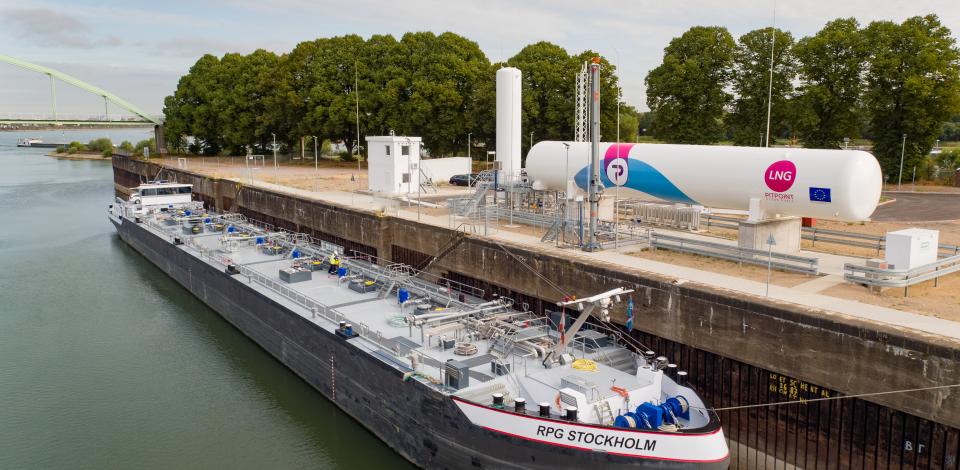LNG stands for liquefied natural gas. Natural gas is liquefied by cooling it down to a very low temperature between -120°C and -162°C, reducing its volume by a factor of 600. This makes LNG easier and safer to store and transport. LNG will not ignite, is odourless, non-toxic and non-corrosive.
Production of LNG
LNG is produced in countries with large natural gas reserves such as Qatar, Australia and Russia, and is transported by ship, an LNG carrier, to locations as close as possible to consumer markets. TotalEnergies, one of the leading companies in LNG, has strong positions in the Middle East, the United States and the North Sea.
At its destination, the ship is unloaded at an LNG terminal where the LNG is regasified, which means that it is converted back into gas. It is then distributed over the network for use in heating and cooking, but also for electricity generation and other industrial applications. LNG that is kept liquefied can be used as an alternative transport fuel, especially for shipping and heavy road transport.
LNG for transport
LNG is the cleanest fossil fuel available for heavy transport over long distances. It has been successfully used by long-haul trucks and large ships for decades, and provides a range of up to 1,500 km. LNG burns cleaner than conventional fossil fuels.
Combustion of LNG produces significantly less local air pollutants, such as nitrogen oxide (NOx), fine particles and sulphur dioxide (SO2) – which still is a challenge in the maritime sector. In most use cases, LNG also produces less greenhouse gas (CO2).
Engines on natural gas for vehicles such as LNG run more quietly than on diesel, which is advantageous for night-time distribution and allows transporters to load and unload outside regular working hours.
The reduction of noise and the resulting nuisance for local residents, combined with the improvement of local air quality, and potential for CO2 reduction, makes LNG a promising alternative fuel to meet increasingly stringent environmental objectives for heavy transport.
Production of biomethane
The renewable and non-fossil variant of LNG is bioLNG. It is made from biomethane and also known as liquefied biomethane or LBM. Biomethane is produced by fermenting biomass into biogas, which is purified and converted into grid quality gas. The biomass can consist of various types of raw materials, or feedstock, such as straw or tree bark and branches, or organic materials, such as food waste, roadside grass, sewage sludge and animal manure.
Biomethane to bioLNG
The biomethane, which consists of the same molecule as natural gas, namely CH4 or methane, is then injected into the gas grid. The natural gas is subsequently extracted from the grid and liquefied by means of an LNG installation to be used as transport fuel. Biomethane can be blended or used up to 100% depending on availability and customer requirements.
As with bioCNG, the use of bioLNG further reduces the emission of CO2, while retaining all the other advantages of LNG, including less engine sound, less NOx and significantly less particulate matter emissions.
Future-proof with LNG vehicles
The availability of bioLNG is currently still limited. However, the switch from LNG to its renewable and more environmentally friendly variant bioLNG does not require any modification of the vehicle. This means that the choice for LNG today allows for a smooth transition to bioLNG in the future and that you can start improving the sustainability of your vehicles now.
Growing network of LNG stations
In Europe, TotalEnergies operates thirteen LNG stations including twelve in The Netherlands, Belgium and Germany, through its joint venture with PitPoint.LNG, and one in France.
In the US, TotalEnergies through its participation in Clean Energy Fuels, operates some 45 (bio)LNG sites.
TotalEnergies and LNG for trucks
Today’s modern LNG trucks are comparable to diesel trucks in terms of power, range and cargo space. There is a wide choice of fully-fledged, advanced LNG trucks available on the market from the leading truck brands.
The European network of LNG refueling stations for trucks is growing steadily. TotalEnergies operates twelve LNG road transport stations in Europe through its joint venture with SHV Energy, PitPoint.LNG:
- In the Netherlands – located in Den Hoorn (Delft), Deventer, Roosendaal, Sevenum (Venlo) and Zwolle.
- In Belgium – located in Antwerpen/Liefkeshoek, Hognoul and Rekkem.
- In Germany – located in Geiselwind, Hirschberg, Alsfeld and Osterfeld.
TotalEnergies and LNG for inland shipping
For inland vessels, LNG as an alternative fuel can offer significant advantages, especially in the light of increasingly stringent emission standards regulations. The commercial potential of LNG can also be interesting for many inland shipping projects. Compared to conventional marine fuel solutions, LNG is price-competitive and in many cases does not require any additional process technology.
In 2019, TotalEnergies, through its joint venture PitPoint.LNG, opened Europe’s first permanent shore-to-ship LNG bunkering station in the port of Cologne, Germany. Strategically located between Basel and Rotterdam, the LNG bunkering station offers a number of benefits to its inland marine shipping and transport customers:
- Shore-to-ship bunkering significantly reduces the complexity of scheduling an appointment compared to truck-to-ship, given its fixed location.
- Faster refueling, thanks to the station’s powerful pumps.
- Opportunity to refuel 24/7, with professional service engineers to provide bunkering services.
For marine vessels, more information on TotalEnergies' worldwide bunkering services can be found on the TotalEnergies Marine Fuels Global Solutions website.
Product benefits
- Reduced vehicle emissions, such local air pollutants* and, especially when bioLNG is used, less greenhouse gases**.
- An LNG engine runs more quietly, which is advantageous for city distribution at night and loading outside regular working hours.
- Increasing selection of modern LNG vehicles available on the market, comparable to diesel trucks in terms of power, range and cargo space.
- Availability of subsidy schemes for LNG in certain countries, such as Germany, which could offer additional cost advantages.
TotalEnergies offer
- A complete offer for LNG refueling stations, for road transport (trucks) and inland marine use (ships), from design to installation.
- Full spectrum of small-scale LNG services, from truck transport of LNG to local regasification units and off-grid power generation.
- Renewable LNG, also known as bioLNG, offer possibilities.
* A study on air quality from the Sustainable Gas Institute (2019), ‘Can natural gas reduce emissions from transport?’, shows that NGV engines provide a NOx reduction of between 40%-60% (depending on the type of road) compared to diesel, by using a simple clean-up system. For particulate matter (PM), NGV engines ensure as much as 95% lower levels compared to diesel, thanks to a soot free combustion (with no need for a complex after-treatment).
** According to the NGVA Europe & Thinkstep study (2017) on the ‘Greenhouse Gas Intensity of Natural Gas in Transport’ (2017), a reduction in CO2 emissions of up to 15% is achieved by driving on LNG compared to diesel for heavy-duty applications and calculated on a 'Well-to-Wheel' basis. Using bioLNG increases the CO2 reduction to as much as 80%.





